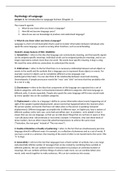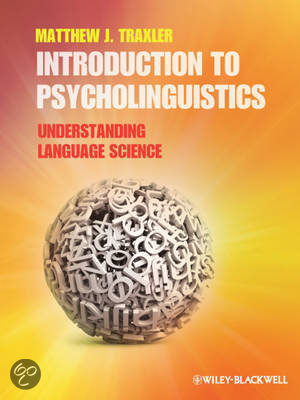Psychology of Language
Lecture 1: An introduction to Language Science (Chapter 1)
The research agenda:
1. What do you know when you know a language?
2. How did we become language users?
3. How do we use our knowledge to produce and understand language?
1. What do you know when you know a language?
Language is a form of communication that is used to transfer information between individuals who
speak the same language, as well as serving other functions, such as social bonding.
Hockett’s design features (1960): (SADDD))
1. Semanticity = refers to the idea that language can communicate meaning, and that specifc signals
can be assigned specifc meanings. Individual words can be assigned particular meanings, and so can
longer expressions contain more than one word. The words have specifc meaning. A dog is a dog.
We need the same arbitrary connections to understand the words.
2. Arbitrariness = refers to the fact that there is no necessary relationship between actual objects or
events in the world and the symbols that a language uses to represent those objects or events. For
example: names for objects can be completely diferent across languages (cat:
koshka/gato/chat/neko). You can also think of the relationship between sound and meaning.
Onomatopoeia: if people pronounce words like “moo” and “oink” we know that they probably refer
to a cow or a pig.
3. Discreteness = refers to the idea that components of the language are organized into a set of
distinct categories, with clearccut boundaries between diferent categories. We know language as
diferent units, it means separable. People who speak the same language will ft every sound made
by every speaker into on the available categories.
4. Displacement = refers to a language’s ability to convey information about events happening out of
sight of the speaker (spataal dispalacemdmnt), about events that happened before the moment when
the person speaks, and events that have not taken place as the person is speaking (tmdporaal
dispalacemdmnt). Diferent languages accomplish this in diferent ways. In English you have a system of
diferent auxiliary verbs (wialal, was, wmrm had) and afxes (prm- in predates; cmd in datmd). In fact it
means that we can use language, so that we can talk about things that are not here in space or time.
I can talk about what I did yesterday or next week. Example: in Mandarin, they lack these kinds of
tense markers, but use other means like adverbial expressions to achieve the same mean
(“Yesterday, the man goes” instead of “The man went”).
5. Double Articulation or Duality of patterning = refers to the fact that we simultaneously perceive
language stimuli in diferent ways: for example, as a collection of phonemes and as a set of words. If
you have a word or a sentence, the meaning of the word or leter is not transferred to the word. (The
“o” in dog).
6. )enerativity = refers to the fact that languages have a fxed number of symbols, but a very large
and potentially infnite number of messages that can be created by combining those symbols in
diferent paterns. We can combine words in new paterns to produce an unlimited number of
meanings. We can combine all these things of units to make more, we can combine leters into
words, ands words together to make sentences. We can turn sentences into essays.
,Phenomenon about GL (gliter/glamour) words
Two chief components of a language
1. )rammar (generated): a system of rules that enabled to combine calls into more complex
messages. Example in book: if vervets had a system “look at the size of that leopard”, now
they can only communicate that there is an leopard, but vervat (probably) not communicate
about the size of the leopard.
2. Lexicon (stored): the part of longcterm memory that stores information about words.
Languages need both of these components so that speakers can formulate messages that express
propositons (statements of who did what to whom, roughly). To create such message, a speaker
searches for symbols in the lexicon that match concepts that she wishes to convey. The grammar
tells how to combine the symbols to create the appropriate signals (speech sounds) that will transmit
a message to a listener.
Components of Languages
● Phonemes: are the units of spoken words. (speech sounds → zachte G / harde G)
● Syllables: Hecliccopcter (letergrepen). A syllable is a unit of pronunciation with one vowel
sound. Some words have just one syllable, while others are made up of multiple syllables.
Unlike a morpheme, a syllable does not have to make meaning. (hapcpy, dogs)
● Morphemes: are defned as the smallest unit of language that can be assigned an
independent meaning. So it are meaningful units in words, they always refer to the same
thing. (happy, dogcs)
● Words: consist of phonetic phonological code (sound), orthographic code (spelling) and
semantic code (meaning).
● Phrases/Clauses: with more words you create sentences.
● Sentences: you use clauses to make sentences.
Misconceptions about grammar
Prescriptive grammar (teached): are collections of artifcial rules on how to write properly (learned
by for example a teacher explanation at primary or upper boundary school).
Descriptive grammar (the natural kind): is the set of systematic rules or principles that governs the
way people use language “in the wild”. That is, how people naturally and normally think and behave.
Language scientist who study grammar prefer studying descriptive grammar because most of them
are interested in the human mind.
Example: “Drank thm ceofmm Mrs Hmidmdann”
We know the rule, so we never say sentences like above. We already know rules, even though
nobody ever tried to teach it to you. (=descriptive grammar).
Exadpalms of dmsceriptim rualms
“Each class can have only one main verb”
“Verbs go in the middle of the sentence”
Three functions of )rammars:
1. Order: the grammar determines the order that symbols appear in expressions. If in English
we want to say red wine, we say red wine (ENG: adjectives before nouns). In French they say
vin rouge or wine red in English (FR: adjectives aaer nouns).
2. Agreement: means that certain words in a sentence must appear in a specifc form because
of the presence of another word in the sentence. For example: when you want to express
something about multiply girls that likes something. You say girls like instead of girls likes,
, which is number agreement. (number agreement (ENG)/gender agreement (ES) → el toro vs.
la toro).
3. Case marking: words must appear in diferent forms depending on what grammatical
functions they fulfll. For instance in English there is case marking in pronounce. Example: Hm
almft NOT Hid almft, I alikm hid NOT Mm alikm hid or I alikm hm). Depending on the function of a
word, the grammar can change the sentences.
Recursion: the ability to place one component inside another component of the same type. You can
have a sentence inside another sentence, so you create a new one. In human language you could
also place one phrase into another phrase of the same type. (example during lecture: making
sentences with ‘susan thinks’ and ‘tom likes beans’ → ‘Susan thinks Tom likes beans). Recursion is
the onaly property that is specifc to human language. Recursion is one of the characteristics that gives
language the property of discermtm infnity, the ability to generate infnite messages (even infnitely
long messages) from fnite means. Recursion can go on and on and is essentially infnite.
Efect recursion:
● It allows the expression of very complex concepts.
● It removes any upper limit on the length of a sentence.
Three ideas about recursion:
1. It’s a core property of all languages. They proposed that recursion is the only property that is
specifc to human language. (Hauser, Fitch, Chomsky, 2002)
2. It’s a core property of all languages, shared with other systems (Pinker & Jackendof, 2005).
3. None of the above. (Everet, 2008)
Daniel Everet: the Piraha does not have sentences like us. They do not use recursion, colors or
numbers and they don’t have history. None of the expressions they use are contained within other
expressions of the same type. Piraha even appears to lack a very simple form of recursion that
happens when you use a coordinate structure to put two noun phrases together. Example: “Dan and
Ted went to Brazil” a Piraha use would say → “Dan went to Brazil. Ted went to Brazil”.
2. How did we become language users?
Human beings did not always have a language. Continuity vs Discontinuity: Lenneberg (1967),
Lieberman (2000), Penn et al. (2008).
1. Continuity hypothesis: Modern human language results from quantitative changes to more
primitive communication systems. Continuity theory views modern humans’ language
abilities as refecting modifcation of abilities that existed in our ancestors.
2. Discontinuity hypothesis: Modern human language is qualitatively diferent from more
primitive communication systems. Discontinuity theory views modern humans’ language as
being distinct and separate from our ancestors’ abilities.
It says you day bm ceodduniceatng with maceh othmr bmform, but that is ceodduniceatonn
Studies of primates
▪ Diana Monkeys: they let the monkeys play in a room and follow it with either real eagle
noises or real jaguar noises. The response to eagle call is muted, the jaguar growl is extreme
agitation. (Semanticity: sound is combined with words).
▪ Kanzi: produces slightly diferent vocalizations in diferent context (juice, grapes and
bananas).
▪ Nim Chimpsky: he never learned to talk; did learn to make signs. Nim must have had an
internal rule that he applied when constructing sequences of signs containing “more” (“more
X” roughly, where X could be replaced by any sign for an object). See also Washoe, he had
the same thing. (terrace et al., 1979)






